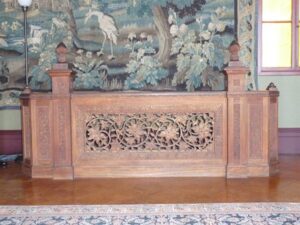Why Lockwood de Forest Now?
Evelyn Trebilcock, Curator and Valerie Balint, Associate Curator

Custom carved teak balustrade in the Corridor of the house at Olana, provided by Lockwood de Forest and made by the Ahmedabad Wood Carving Company, India, c. 1887 photo by Melanie Hasbrook 2014
There has recently been a revival of serious interest in the decorator/artist Lockwood de Forest (1850-1932). We would like to think this past summer’s exhibition All the Raj— Frederic Church and Lockwood de Forest: Painting, Decorating, and Collecting at Olana, organized with guest curator Professor Roberta A. Mayer, was a contributing factor.
But maybe the most important catalyst was the September 2013 sale of a pair of de Forest chairs at Bonham’s for the record price of $242,500 to the Virginia Museum of Fine Arts.
By the time of the sale, our exhibition at Olana was already in the works as a complement to the recently opened Cooper-Hewitt National Design Museum show, Passion for the Exotic: Lockwood de Forest, Frederic Church. The exhibition celebrates the newly restored Carnegie family library, designed by Lockwood de Forest, and features some of the 2,026 Church sketches in the museum’s collection, as well as objects on loan from private collectors, de Forest descendants, and Olana.
Olana is important to any discussion of Lockwood de Forest; he was he was one of the few artists that Frederic Edwin Church chose to encourage and mentor, and their relationship grew into one of collaboration. Unlike many of his other projects in which de Forest would create an entire “Indian Room,” as in the Carnegie Library, for Church’s interiors de Forest provided material that Church integrated throughout his entire home; or in some cases Church himself provided the design that de Forest then had executed in India. In his later years de Forest reflected, “This close association with Mr. Church, I think now the most important factor in my own development.”
De Forest believed strongly in the artistic importance of Indian design and in his later years he tried to sell his collection to museums, with varying success. The Indianapolis Museum of Art has reassessed the de Forest pieces in their collection, including an amazing 300-piece wall acquired in 1915, comprised of carved teak, sandstone and metal components. They have found all the parts even though over the years it had been dispersed throughout the museum, and repurposed by numerous departments. Other museums have begun to recognize the importance of de Forest in terms of his place in a comprehensive survey of American decorative arts by acquiring pieces as the Munson-Williams-Proctor Art Institute, Utica did in 2013 when Director Anna D’Ambrosio added a c. 1895 de Forest carved chair to the already strong collection of decorative arts in the museum.
Dealers like Frank Goss, Associated Artists and Gavin Spainerman (now at Gerald Peters Gallery) have been showing de Forest plein air sketches on paper. They are lovely examples of the artist’s life-long passion for painting and definitely show a debt to Church’s training as well as de Forest coming into his own as an artist. Debra Force Gallery in New York City has just opened an exhibition that shows sketches, paintings and decorative art, which will be on view through March 13th.
Intellectual exploration of de Forest is available for the public and scholars. On Thursday February 5th at 5:30 pm, the Cooper-Hewitt, in collaboration with The Olana Partnership, is hosting a special viewing of the de Forest room and a panel discussion with Curators Sarah Coffin, Gail Davidson and de Forest expert Roberta Mayer, who recently re-examined de Forest’s papers at the Archives of American Art, resulting in an article in the Archive’s journal in early 2014. The following day, Amy Poster, independent curator and consultant, and member of Olana’s Curatorial Advisory Committee, is organizing a scholarly roundtable on de Forest focusing on the significance of Indian art to his designs for American domestic interiors and museums, as well as his efforts to preserve traditional Indian handicraft. Olana Curator Evelyn Trebilcock will make a presentation on Lockwood de Forest at Olana.
While de Forest has enjoyed a coterie of devotees for decades both inside and outside of the museum world, both his broader public and scholarly focus are now on the rise. In the past de Forest may have been considered as someone hard to define: designer, yet also importer and collector of works created by others. His efforts could be considered to fall both inside and outside of either strictly American or Asian/Indian disciplines of artistic consideration. His relationship with Louis Comfort Tiffany has resulted in de Forest being eclipsed by a more well-known name, whose work has perhaps been considered more visionary. As the art history field becomes more interdisciplinary in its intellectual inquiry, and the world increasingly becomes more global, it seems a perfect time to acknowledge that Tiffany is only one of many talented Aesthetic Movement designers. De Forest’s initial training and life-long association with Church, the most important American landscape painter of the third quarter of the nineteenth century, set him on the course to be a great designer. While taste and fashion changed as the century closed, and many of de Forest’s interiors were destroyed, the singular pieces and interiors that remain begin to again be recognized for their intrinsic quality. De Forests’ unique relationship with India and its traditional design, has an allure to a Western audience who is attracted to the exotic qualities of its craft tradition, and seeks to learn more about a country which plays an increasingly larger role on the global technology and democratic stage.

